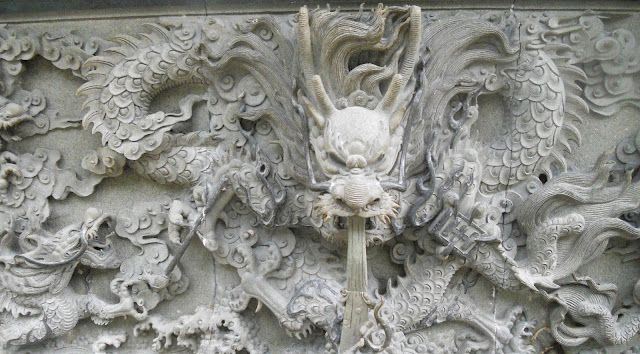In my last post, I described my most recent visit to ghost alley, but there is a completely different attraction that is a mere five minutes walk away. Wun Chuen Sin Koon is a Taoist monastery that is well worth a visit; in fact, you could probably spend an entire day here, given how many interesting things there are to see.
The complex is modelled on a Taoist temple in Xiqiao, Guangdong province. The priests there fled the Japanese invasion of China in 1938 and set about recreating that temple in Hong Kong. The entire site is dedicated to Taoist master Lu Chunyang.
If you’re approaching the site from ghost alley, then you will enter via the back door, but the 52K minibus from Fanling station passes the main entrance, and the first thing you will see if coming this way is the finest example of the three immortals that I have ever seen:
You may have seen ceramic representations of these three figures in restaurants and other public venues, but they would be a mere 40–50cm in height. These figures are 6–7 metres tall!
Once you’ve walked past Fuk, Luk and Sau (the names of these three figures, from right to left), the first thing you will see is this temple:
Things to note here include the fish on the roof ridge, which are a symbol of longevity; the tripod in the foreground, which is used by worshippers to plant burning joss sticks; the dragon motifs above the doorway; and the bizarre line of mythical creatures where the roof flares upwards at the corners.
However, if you walk through this temple, there is a spectacular open space with a much larger temple at the back:
The line of mythical creatures on the roof corners is longer, and the roof ridge features two dragons. The tripod for joss sticks in the foreground is even more elaborate than the previous one.
On each side of the second flight of stairs, there is a guarding lion that looks quite unlike any other lions I’ve seen. This is the one on the left:
And this is a view of the main temple from the balcony of a building on the left:
The dragon motifs and the lines of mythical creatures on the roof corners are obvious in this photo.
I imagine that the grounds here have been designed to enable meditation, and running water is always a contemplative subject:
I don’t know why these buffalo statues are here, but it probably reflects the reverence for nature that is integral to Taoism:
Finally, when I saw this bas-relief panel, I knew immediately what it represents:
It is a depiction of Ao Guang, the dragon king of the East Sea, and his eight sons:
This photo shows just how intricately detailed is the entire panel:
This account is far from comprehensive in terms of what there is to see here. However, I hope that it provides some incentive to come and see for yourself. Wun Chuen Sin Koon is at least as interesting as other temples/monasteries that are much better known to tourists.
Sunday, 20 October 2019
Subscribe to:
Post Comments (Atom)












I still like visiting cultural places around the area as we notice different features or changes around in each visit. This time, we noticed that the lotus pond was drained and no lotus flowers were to be flourished...
ReplyDelete...just so long as there aren’t too many other visitors!
Delete